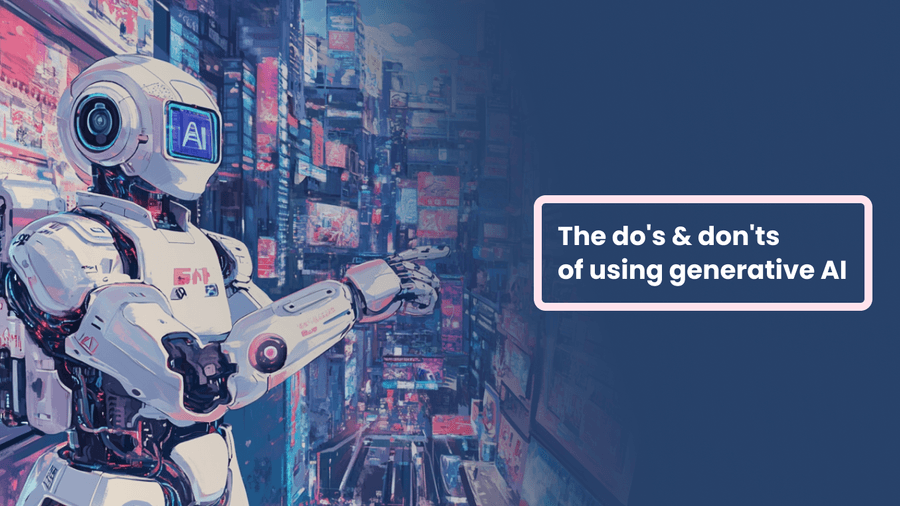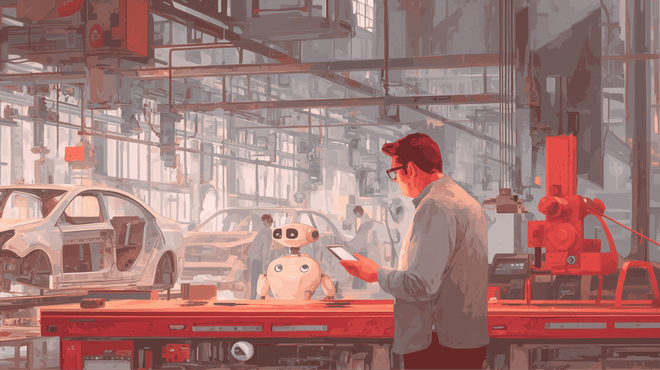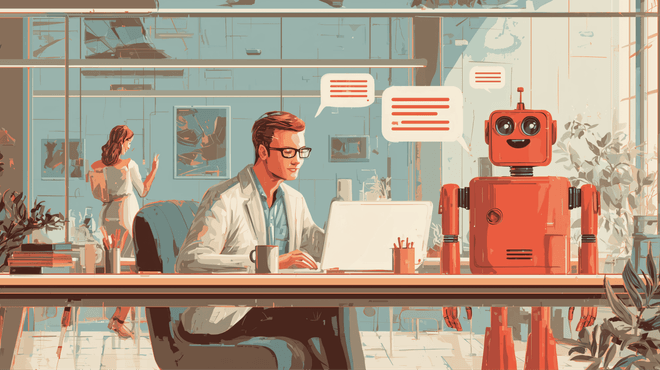According to Gartner, generative AI is one of the most deployed AI techniques. In 2023, 92% of Fortune 500 companies were using generative AI, reports Financial Times. And today, this percentage must be higher as this widespread AI fad shows no signs of slowing down.
But in the rush to innovate, it’s easy to find yourself pouring money into a technology that not only doesn’t deliver returns but ends up costing more than expected. At Aristek, we believe that AI investments may be hefty upfront, but over time, they should pay off double – or why invest at all? After all, the goal is to become AI-driven, not money-drained.
To help you avoid that pitfall, we’ve put together this article to explore when generative AI can bring real value and when other solutions might be a smarter choice.
How AI became generative
But first, let’s take a quick trip down memory lane to discover how AI became generative. If you’re not familiar with AI terminology, you can read our article where AI concepts are explained in plain English.
The idea of creating something like AI dates back to ancient times when inventors made “automatons” – machines that could move and perform tasks on their own. Fast forward to the 20th century, and we meet Alan Turing, who helped lay the foundation for modern computing and artificial intelligence.
At first, AI was good at tasks like sorting images of cats and dogs. However, researchers wanted AI to do more than just recognize patterns. Suddenly, it looked like artificial intelligence was beginning to show a hint of creativity…
The birth of generative AI
Generative AI’s roots go back to the early days of machine learning (ML). When scientists introduced ML in the 1950s, they were fascinated by the idea of using algorithms to create new data. In fact, there was already a model that laid the groundwork – the Markov chain, presented in 1907. It was a statistical model that could generate new data sequences based on existing input.

However, for a long time, though, this idea remained more of a concept. The tech back then just didn’t have the computing power to bring it to life. Everything changed in the 1990s and early 2000s, when better hardware and loads of digital data finally gave machine learning the boost it needed.
Neural networks as an important milestone in gen AI development
But the development of gen AI, as we know it today, became possible with the advent of a type of ML known as neural networks – the technology inspired by the human brain. Neural networks rely on layers of interconnected “neurons” to process data and learn from it. Once trained, these networks can recognize patterns and make predictions without needing detailed instructions for every task.
Learn more about ML and neural networks.
The real creative spark in generative AI comes from a type of neural network called a Generative Adversarial Network (GAN), introduced by Ian Goodfellow and his team in 2014. This breakthrough lets machines generate completely new data, like images or text, from scratch. It was like giving AI the tools to think up something new rather than just imitating what it’s seen.
But GANs weren’t the only ones pushing the boundaries. Around the same time, other models like Variational Autoencoders (VAEs) and Recurrent Neural Networks (RNNs) also started showing their potential to create original content. These developments marked a big leap forward and laid the groundwork for the sophisticated generative models we use today.
The sparks that lit the fire
If generative AI has been around since 2014, why has it only exploded in popularity recently? The answer lies in a series of key breakthroughs over the past decade:
- In 2016, DeepMind introduced WaveNet, a neural network capable of generating incredibly realistic human speech. This was a game changer for AI’s ability to create natural-sounding voices.
- Then in 2017, NVIDIA released Progressive GANs, an innovation that improved the quality of AI-generated images. By progressively refining its results, the AI could generate high-resolution images that were sharper and more lifelike than anything seen before.
- In 2019 and 2020, OpenAI unveiled GPT-2 and GPT-3, powerful language models capable of generating human-like text. These models could write essays, answer questions, and even create code – pushing the boundaries of what AI could do with language.
- Next came DALL-E in 2022, again from OpenAI. This solution could generate detailed and creative images from simple text descriptions.
- Later that same year, ChatGPT was released. This technology finally gave AI a conversational edge. It allowed people to engage with AI in a whole new way, making natural, flowing dialogue possible for the first time.
- In 2023 and 2024, OpenAI continued improving ChatGPT with GPT-4 and GPT-4o releases. New versions added more depth, context, and accuracy to the conversations and content AI could create.
The wider race for AI dominance
While OpenAI might be leading the charge in generative AI, they’re far from running solo. Amazon has stepped up with tools like AWS DeepComposer, giving developers the chance to create music with generative AI. Google has also made its mark, with projects like DeepDream and MuseNet pushing creative AI to new heights, from surreal images to AI-generated tunes.
But none of this compares to the hype surrounding DeepSeek. For users, it functions much like ChatGPT, but under the hood, things are quite different. DeepSeek’s R1 models were trained using a unique approach that required less time, fewer AI accelerators, and significantly lower costs than OpenAI’s methods.
This efficiency has made DeepSeek a major player in the AI landscape, however, it’s too early to call it a true rival to OpenAI. Deepseek still faces serious security concerns, raising questions about its readiness for widespread adoption.
Still, each of these milestones has brought generative AI closer to what it can do today. And with the amount of investments pouring into this domain, we can expect even more breakthroughs ahead.

As we observe the fast-paced AI race, why not absorb its potential by integrating generative AI into your business strategy?
But before that, let’s take a look at when generative AI can be your go-to partner and when it might slow your progress down.
Where is gen AI effective?
Content creation
As the name suggests, generative AI shines when it comes to crafting articles, scripts, and various other content. While it often draws from existing works, meaning the ideas might not always be groundbreaking, it’s a reliable ally when you’re pressed for time or short on resources. So, when deadlines loom and creativity feels tapped out, generative AI can step in.
Beyond just generating text, it offers a range of other capabilities:
- Text manipulation. Need to soften the tone or professionalize your writing? Generative AI can help!
- Summarization. Gen AI can distill lengthy articles into concise summaries, making information easier to digest.
- Classification. The technology helps organize content for specific use cases quickly and easily.
We build AI that saves time and drives growth.
Discover how we developed an AI-powered content generator for knowledge assessment, helping our client save 90% in quiz creation time, achieve a +4 point increase in NPS, and boost conversion rates by 27%!

Design and art
Generative AI is also a powerhouse in image generation. It has a good ability to create visuals based on text prompts, apply stylish effects, or mimic the style of famous artists.
Of course, it has its quirks (just ask anyone who’s seen AI-generated hands!), so for more intricate artwork, human artists are still essential. However, when it comes to producing simple designs like banners or diagrams in bulk, an AI image generator is a fantastic helper.

Organizational productivity
The magic of generative AI lies in its adaptability. The tool can be easily fine-tuned for various tasks, which allows it to take on a multitude of roles within an organization. Imagine chatbots that chat like your most charming friend, content generation tools that whip up ideas faster than you can say “brainstorm,” and countless other solutions that make life easier.
These capabilities can enhance productivity by:
- Answering questions with a conversational flair;
- Easing the burden of repetitive tasks;
- Providing accessible summaries of complex topics;
- Generating automatic translations and transcriptions, etc.
Learn how we built the LLM-based chatbot for an eLearning company
Our solution helped the client optimize routine tasks and allowed a support team to handle complex tickets quickly.
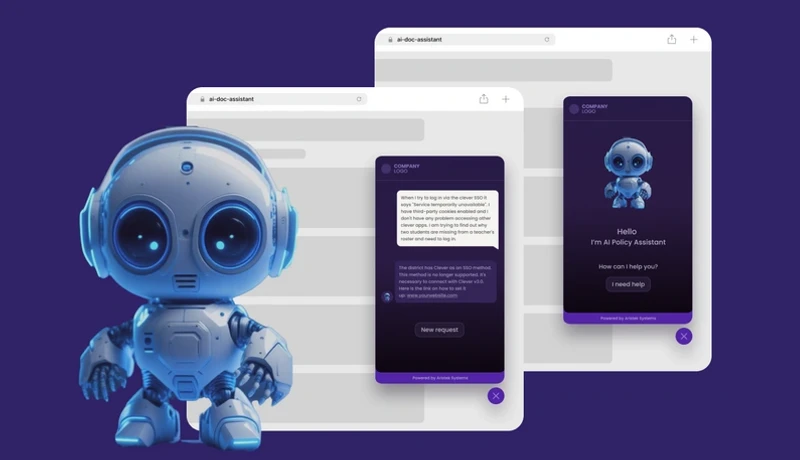
Personalized recommendations
Generative AI is a good tool for analyzing user data to offer tailored suggestions. It looks at behavior, preferences, and purchase history to provide spot-on recommendations.
Instead of generic ads, it generates unique product descriptions and personalized messages that truly connect with users. As they interact, AI adapts in real-time, changing suggestions based on clicks or searches.
It also knows how to make smart cross-sells and upsells, suggesting items that perfectly complement what users are interested in. Plus, it keeps the conversation going with personalized emails and notifications, enhancing engagement and making every shopping experience feel custom-fit.
Language translation
Yes, trusty old Google Translate still gets the job done, but generative AI takes translation to the next level. It offers context-aware translations, adapting to tone and style far better than traditional tools.
With its ability to produce natural-sounding phrases and maintain conversational flow, generative AI is perfect for nuanced or creative content. Plus, it learns from user interactions, continuously improving its personalization and accuracy over time.
Where gen AI is not always the best option (yet)
But gen AI is not a silver bullet. Its success depends on when and how it is applied.
Decision intelligence
Intelligent? Yes, but not decision-savvy. Generative AI can be smart, but when it comes to making nuanced decisions that require human insight, it struggles. It might suggest options, but it often misses the subtlety of context and emotional intelligence that humans bring to the table.
Instead, consider using decision support systems that combine human expertise with data analytics, and can provide more informed insights while keeping the human touch intact.
Prediction and forecasting
When it comes to making accurate predictions, generative AI can be hit or miss. While it may generate broad ideas based on patterns, it lacks the precision and dependability often needed in forecasting. Relying on it to predict the next big trend might feel like using a weather app that only forecasts “some clouds” for every day of the week.
For better accuracy, try using advanced statistical models or machine learning algorithms specifically designed for prediction – they can analyze historical data more effectively.
Want to predict future outcomes and make informed decisions?
Our predictive analytics services can transform your data into clear forecasts and strategic opportunities.
Planning
Generative AI can assist in generating ideas, but it falls short in creating detailed plans that consider all variables and contingencies. It’s like having a map that shows you the general direction but doesn’t guide you around roadblocks or unexpected detours.
Instead, use project management tools that integrate human input for better planning and real-time adjustments, which results in a more comprehensive approach to project execution.
Creativity
Yes, generative AI can produce art and writing, but it leans heavily on existing data. Think of it as a talented mimic – it can perform but doesn’t invent. Shakespeare’s sonnets? Safe from AI’s grasp (at least until machines start dreaming in iambic pentameter).
The best source for genuine creativity remains human artists and writers who can draw from personal experience and emotion.
Autonomous systems
Generative AI is not well-suited for fully autonomous systems that need to operate independently and adapt in real time. While it can assist with tasks, it can’t navigate unexpected situations like a human can. When the going gets tough, the tough need more than just algorithms.
For autonomous tasks, look towards advanced robotics or IoT systems equipped with adaptive algorithms that can learn and respond promptly.
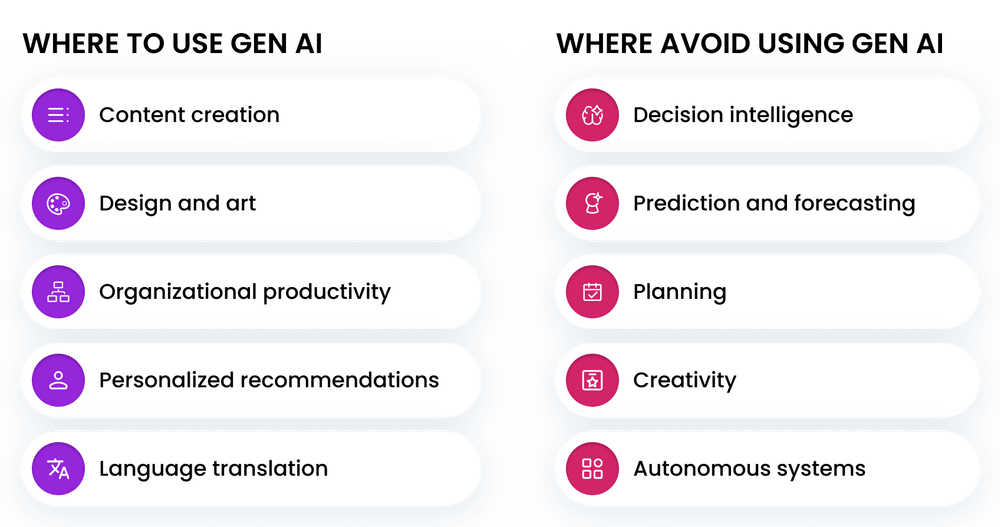
Bottom line
We understand that choosing the best tool can be a challenging task, but you don’t have to do it alone. If you’re unsure which solution fits your needs, partnering with Aristek might be your best move. We listen to your requirements, conduct thorough audits of your systems and data, and guide you in selecting and implementing the right tools.
Don’t wait for the perfect moment – reach out to us today and let’s turn your AI aspirations into reality!
